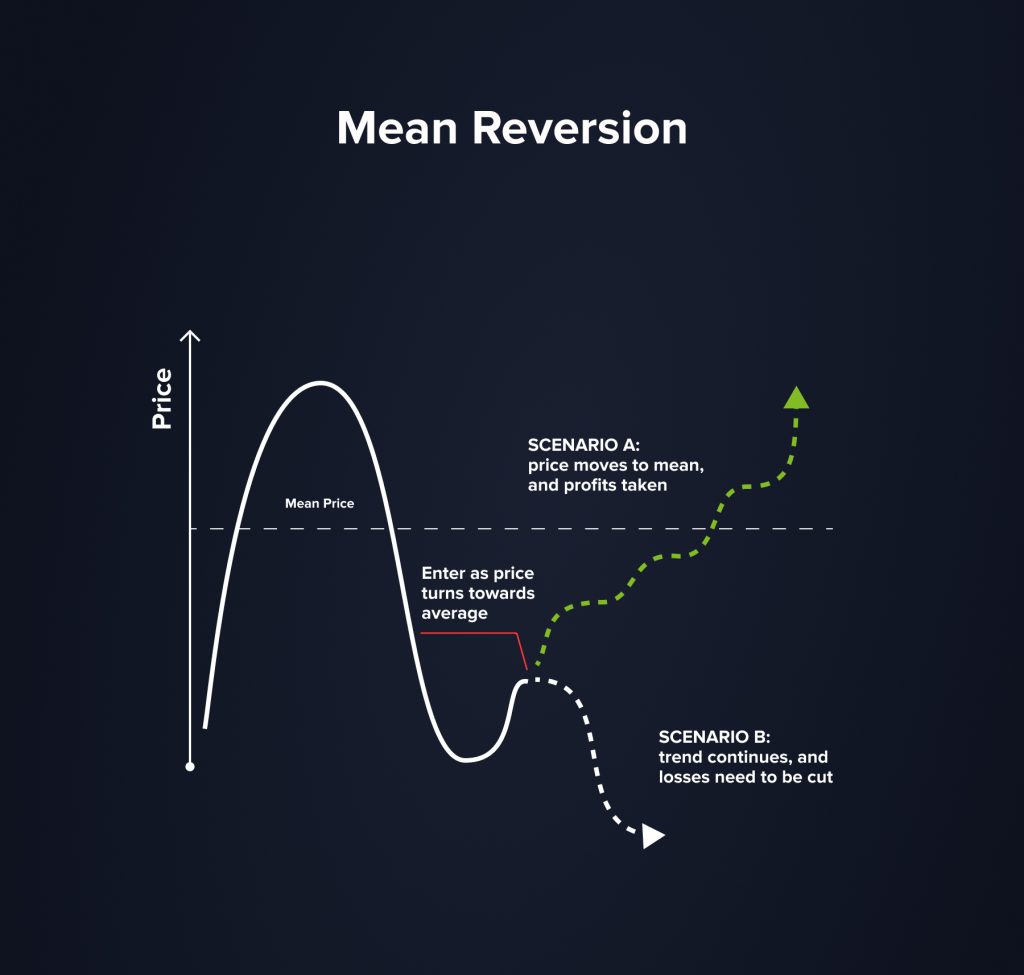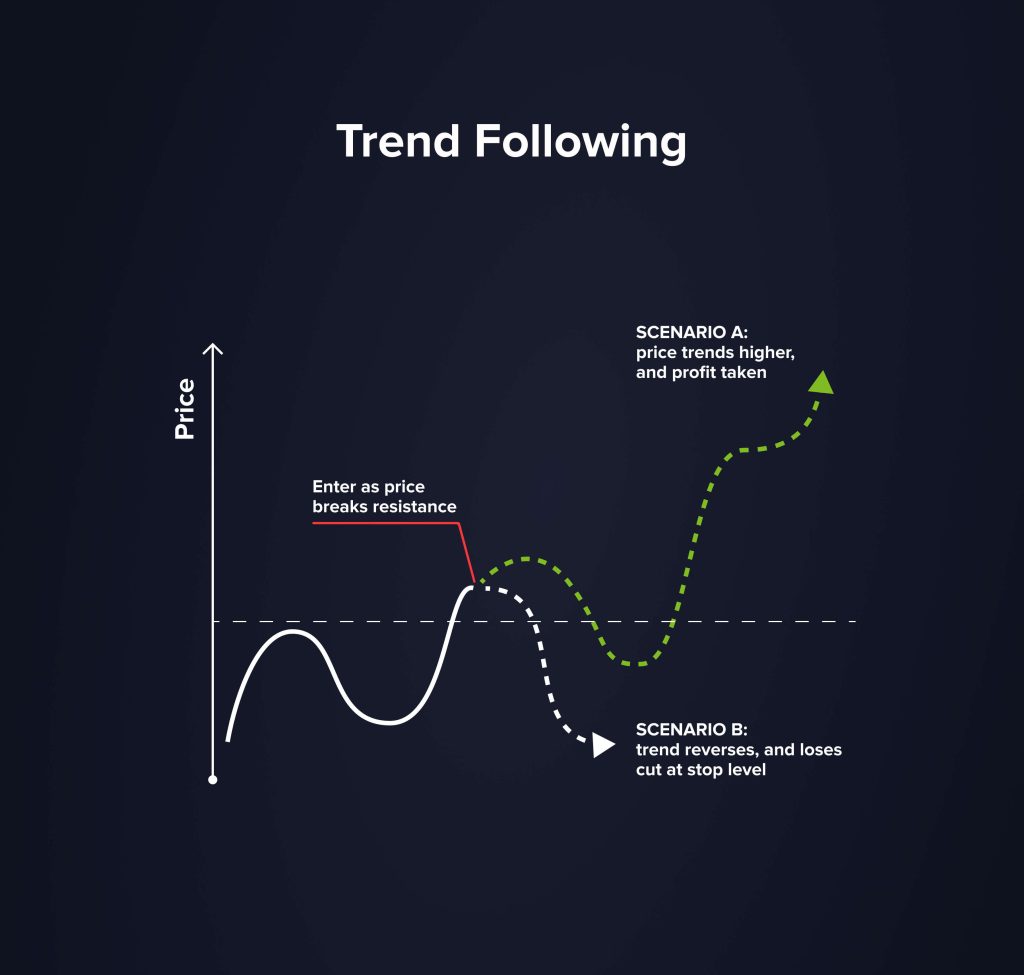
15 กลยุทธ์การซื้อขายยอดนิยมในปี 2025
เนื้อหา
ในตลาดการเงินที่ซับซ้อน กลยุทธ์การซื้อขายที่แข็งแกร่งเปรียบเสมือนแสงนำทาง กลยุทธ์นี้ช่วยนำทางเทรดเดอร์ มอบทิศทางที่ชัดเจนท่ามกลางความไม่แน่นอนของการซื้อขายสินทรัพย์หลากหลายประเภท การเข้าใจรายละเอียดปลีกย่อยของกลยุทธ์เหล่านี้จึงเป็นสิ่งสำคัญ แม้ว่าจะมีกลยุทธ์ที่หลากหลายให้เลือกใช้ก็ตาม บทความนี้จะนำเสนอเทคนิคการซื้อขายที่ได้รับการยอมรับมากที่สุด 15 เทคนิค ซึ่งล้วนออกแบบมาเพื่อรับมือกับความยากลำบากเฉพาะตัวของตลาดแต่ละแห่ง กลยุทธ์เหล่านี้และความทุ่มเทในการบริหารความเสี่ยงจะช่วยให้เทรดเดอร์คว้าโอกาสในการซื้อขายได้อย่างมั่นใจ
พื้นฐานของกลยุทธ์การซื้อขาย
สิ่งสำคัญคือต้องเข้าใจจุดประสงค์พื้นฐานของแผนการซื้อขายแต่ละแผนก่อนที่จะลงรายละเอียดของแต่ละแผน กลยุทธ์การซื้อขาย โดยพื้นฐานแล้วเป็นวิธีการทำสิ่งต่างๆ อย่างเป็นระบบ หรือชุดกฎเกณฑ์ที่เทรดเดอร์ปฏิบัติตามเพื่อตัดสินใจซื้อขายอย่างชาญฉลาด กฎเกณฑ์เหล่านี้ช่วยควบคุมความรู้สึก เพื่อให้การตัดสินใจเป็นไปตามเหตุผลและการค้นคว้า แทนที่จะใช้อารมณ์
การเลือกกลยุทธ์ที่เหมาะสมก็เหมือนกับการเลือกตราสารที่เหมาะสมสำหรับงานเฉพาะอย่างหนึ่ง การพัฒนากลยุทธ์ควรคำนึงถึงวัตถุประสงค์ของเทรดเดอร์ ระดับความเสี่ยงที่ยอมรับได้ และระยะเวลาการลงทุน ตัวอย่างเช่น ผู้ที่กังวลในระยะยาวอาจเลือกการซื้อขายแบบ Position Trading ในขณะที่ผู้ที่ต้องการเงินทุนทันทีอาจเลือก Day Trading หรือ Cut ในทำนองเดียวกัน เทรดเดอร์ที่ระมัดระวังมากกว่าจะชอบซื้อหุ้นที่ได้รับการยอมรับหรือ Forex ในขณะที่เทรดเดอร์ที่พร้อมรับความเสี่ยงสูงอาจพิจารณาคริปโตเคอร์เรนซีที่มีความผันผวนมากกว่า
การทำความเข้าใจแนวคิดพื้นฐานของกลยุทธ์แต่ละอย่างและนำมาปรับใช้ให้สอดคล้องกับรูปแบบการเทรดจะช่วยให้เทรดเดอร์สามารถปรับปรุงประสิทธิภาพและเพิ่มประสิทธิภาพการเคลื่อนไหวของตลาดได้อย่างเต็มที่ แม้ว่ากลยุทธ์ต่างๆ อาจเหมาะสมกับความต้องการของเทรดเดอร์แต่ละรายไม่มากก็น้อย แต่ควรทราบว่าวิธีการต่างๆ ที่แสดงด้านล่างนี้ไม่ได้เรียงลำดับอย่างใดอย่างหนึ่ง
15 กลยุทธ์การซื้อขายยอดนิยม
- การติดตามแนวโน้ม
- การซื้อขายโมเมนตัม
- การซื้อขายแบบสวิง
- การซื้อขายแบบตำแหน่ง
- การซื้อขายรายวัน
- การถลกหนังหัว
- การกลับคืนสู่ค่าเฉลี่ย
- การซื้อขายความถี่สูง (HFT)
- การซื้อขายแบบ Breakout
- การซื้อขายข่าว
- การเก็งกำไร
- การสร้างตลาด
- กลยุทธ์ตัวเลือก
- การซื้อขายแบบคู่
- การเฉลี่ยต้นทุนดอลลาร์
1. การติดตามแนวโน้ม

ในภูมิทัศน์ทางการเงินที่หลากหลาย การติดตามแนวโน้ม (Trend Following) กลายเป็นกลยุทธ์ที่เชื่อถือได้ หลักการง่ายๆ คือ ใช้ประโยชน์จากโมเมนตัมของสินทรัพย์ในทิศทางใดทิศทางหนึ่ง ไม่ว่าจะเป็นหุ้น คริปโทเคอร์เรนซี หรือออปชัน คุณอาจเคยได้ยินคำกล่าวที่ว่า “แนวโน้มคือเพื่อนของคุณ” กุญแจสำคัญของกลยุทธ์นี้คืออินดิเคเตอร์ทางเทคนิคต่างๆ เช่น ค่าเฉลี่ยเคลื่อนที่ ซึ่งช่วยให้เทรดเดอร์สามารถแยกแยะแนวโน้มโดยรวมได้
การควบคุมพลังของแนวโน้มช่วยให้เทรดเดอร์สามารถรับมือกับความผันผวนของตลาด และทำกำไรได้แม้สินทรัพย์จะเคลื่อนไหวในทิศทางที่ยาวขึ้น อย่างไรก็ตาม การประเมินความยาวนานที่แท้จริงของแนวโน้มยังคงเป็นความท้าทาย เครื่องมือและตัวบ่งชี้ทางเทคนิคในการเทรดมีความสำคัญอย่างยิ่งในการไขข้อข้องใจนี้ โดยให้สัญญาณที่ช่วยระบุจุดเริ่มต้นและจุดสิ้นสุดของการเคลื่อนไหวที่สำคัญของตลาด
การติดตามแนวโน้มในการปฏิบัติ
ตัวบ่งชี้ทางเทคนิคที่จะเปิดใช้งาน: สมา200, สมา50, สมา20.
เปิดสถานะซื้อเมื่อ:
- ราคาสินทรัพย์อยู่เหนือเส้น SMA 200
- ราคาสินทรัพย์แตะเส้น SMA 20 อย่างน้อยสามครั้ง (ควรเปิดสถานะหลังจากแตะครั้งที่สาม) ปิดสถานะเมื่อแท่งเทียนปิดเหนือเส้น SMA 50
เปิดสถานะขายเมื่อ:
- ราคาสินทรัพย์อยู่ต่ำกว่าเส้น SMA 200
- ราคาสินทรัพย์แตะเส้น SMA 20 อย่างน้อยสามครั้ง (ควรเปิดสถานะหลังจากแตะครั้งที่สาม) ปิดสถานะเมื่อแท่งเทียนปิดเหนือเส้น SMA 50
2. การซื้อขายโมเมนตัม
การซื้อขายแบบโมเมนตัม ดังชื่อที่บ่งบอก มุ่งเน้นไปที่การเพิ่มโมเมนตัมปัจจุบันให้สูงสุดในการเคลื่อนไหวของราคาสินทรัพย์ แนวคิดหลักในการซื้อขายคือการซื้อสินทรัพย์ที่กำลังเพิ่มขึ้นและขายสินทรัพย์ที่กำลังลดลง ความเชื่อที่อยู่เบื้องหลังกลยุทธ์นี้คือสินทรัพย์ที่เคลื่อนไหวไปในทิศทางใดทิศทางหนึ่งจะยังคงเคลื่อนไหวในทิศทางนั้นต่อไปอีกระยะหนึ่ง
อย่างไรก็ตาม จำเป็นต้องมีทักษะการวิเคราะห์ที่เฉียบคมเพื่อควบคุมพลังของการเทรดโมเมนตัม เครื่องมือต่างๆ เช่น ค่าเฉลี่ยเคลื่อนที่และปริมาณการซื้อขาย สามารถให้ข้อมูลเชิงลึกอันล้ำค่าว่าแนวโน้มนั้นมีพลังเพียงพอที่จะดำเนินต่อไปหรือไม่ แม้ว่าโอกาสจะน่าสนใจ แต่สิ่งสำคัญคือต้องตระหนักว่าการเทรดโมเมนตัมอาจมีความเสี่ยงต่อการกลับตัวของตลาดอย่างกะทันหัน ทำให้การบริหารความเสี่ยงอย่างเหมาะสมเป็นสิ่งจำเป็น
การซื้อขายโมเมนตัมในทางปฏิบัติ
ตัวบ่งชี้ทางเทคนิคที่จะเปิดใช้งาน: SMA 5, SMA 10, RSI (การตั้งค่าเริ่มต้น), สุ่ม (14, 3, 3)
เปิดสถานะซื้อเมื่อ:
- เส้น SMA 5 ตัดผ่านเส้น SMA 10 ค่า Stochastic ขยับขึ้น RSI สูงกว่า 50
เปิดสถานะขายเมื่อ:
- เส้น SMA 10 ตัดกับเส้น SMA 5 ค่า Stochastic ลง และ RSI ต่ำกว่า 50
3. การซื้อขายแบบสวิง
การซื้อขายแบบสวิงจะสร้างสมดุลระหว่าง การซื้อขายรายวัน และการซื้อขายแบบ Position Trading กลยุทธ์นี้มุ่งเน้นไปที่การจับจังหวะ “แกว่งตัว” ของราคา หรือการเคลื่อนไหวของราคาในระยะสั้นถึงระยะกลาง แทนที่จะปล่อยให้ตลาดผันผวนยาวๆ หรือความผันผวนรายวันแบบชั่วคราว เทรดเดอร์แบบ Swing Trading จะประสบความสำเร็จในระยะกลาง โดยทำกำไรจากราคาหุ้นหรือตราสารทางการเงินใดๆ ในช่วงเวลาเพียงไม่กี่วันไปจนถึงหลายสัปดาห์
การเทรดแบบสวิงเทรดต้องอาศัยความอดทน แม้ว่าเดย์เทรดเดอร์ที่แอคทีฟอาจมองว่ามันช้า และโพซิชั่นเทรดเดอร์อาจมองว่ามันไม่สม่ำเสมอ แต่สวิงเทรดเดอร์กลับชื่นชอบจังหวะนี้ ซึ่งทำให้สามารถตัดสินใจเทรดได้อย่างรอบรู้ แนวรับและแนวต้านมีความสำคัญอย่างยิ่งยวดในคลังแสงของพวกเขา ซึ่งทำหน้าที่เป็นตัวชี้วัดสำหรับการซื้อขาย
การซื้อขายแบบสวิงในทางปฏิบัติ
ตัวบ่งชี้ทางเทคนิคที่จะเปิดใช้งาน: รูปแบบกราฟิคกลับด้าน
เปิดสถานะซื้อเมื่อ:
- รูปแบบ Double Bottom, Inverted Head & Shoulders, Cup & Handle และรูปแบบอื่นๆ ปรากฏบนแผนภูมิ
เปิดสถานะขายเมื่อ:
- รูปแบบ Double Top, Head & Shoulders, Expanding Triangle และรูปแบบอื่นๆ ปรากฏบนแผนภูมิ
4. การซื้อขายแบบตำแหน่ง
การซื้อขายแบบ Position Trading ถือเป็นกลยุทธ์เชิงกลยุทธ์มากกว่า โดยเกี่ยวข้องกับการถือครองตราสารทางการเงินของคุณ ไม่ว่าจะเป็นหุ้น ฟอเร็กซ์ หรือคริปโตเคอร์เรนซี เป็นระยะเวลานาน ตั้งแต่หลายสัปดาห์ไปจนถึงหลายปี กลยุทธ์นี้มีพื้นฐานมาจากการวิเคราะห์ปัจจัยพื้นฐานอย่างละเอียดถี่ถ้วน โดยมีการวิเคราะห์ทางเทคนิคเป็นเครื่องมือเสริม
นักลงทุนแบบ Position มักไม่ค่อยกังวลเกี่ยวกับความผันผวนของตลาดในระยะสั้น เพราะพวกเขาเป็นนักลงทุนระยะยาวที่ขึ้นอยู่กับทิศทางโดยรวมของตลาด มักอาศัยการวิจัยเชิงลึกที่ครอบคลุมถึงผลการดำเนินงานขององค์กร แนวโน้มอุตสาหกรรม และตัวชี้วัดทางเศรษฐกิจทั่วไป การตัดสินใจของพวกเขาจึงสะท้อนถึงการพิจารณาอย่างรอบคอบ
การซื้อขายตำแหน่งในทางปฏิบัติ
ตัวบ่งชี้ทางเทคนิคที่จะเปิดใช้งาน: แถบบอลลิงเจอร์
เปิดสถานะซื้อเมื่อ:
- ราคาสินทรัพย์ทะลุขอบบนของ Bollinger Bands
เปิดสถานะขายเมื่อ:
- ราคาสินทรัพย์ทะลุขอบล่างของ Bollinger Bands
5. การซื้อขายรายวัน
หนึ่งในเทคนิคที่กล่าวถึงบ่อยที่สุดในแวดวงการเงินหลากหลายสาขาคือเดย์เทรดดิ้ง เดย์เทรดดิ้ง (Day Trading) ดังชื่อที่บ่งบอก ประกอบด้วยการเปิดและปิดสถานะการซื้อขายตลอดหนึ่งวันทำการ วิธีนี้มุ่งหวังที่จะทำกำไรจากการเคลื่อนไหวของราคาชั่วคราว ขณะเดียวกันก็หลีกเลี่ยงความเสี่ยงที่อาจเกิดขึ้นในช่วงข้ามคืน เช่น ข่าวร้ายหรือเหตุการณ์ระดับโลกที่ส่งผลกระทบต่อราคาหุ้นหรือมูลค่าของสกุลเงิน ระบบการซื้อขายสมัยใหม่ในปัจจุบันช่วยให้เทรดเดอร์สามารถดำเนินการสั่งซื้อและขายได้อย่างรวดเร็ว จึงช่วยเพิ่มประสิทธิภาพแม้ในยามที่ราคาเคลื่อนไหวเพียงเล็กน้อย
การซื้อขายแบบเดย์เทรดมีความเสี่ยงสูง แม้ว่ากำไรจะดึงดูดใจเทรดเดอร์ได้เร็วก็ตาม ในสภาพแวดล้อมที่วุ่นวายเช่นนี้ จำเป็นต้องมีการคิดอย่างเฉียบแหลม ปฏิกิริยาตอบสนองที่รวดเร็ว และความสามารถในการวิเคราะห์ทางเทคนิค ความคาดหวังที่สมเหตุสมผลและกลยุทธ์การบริหารความเสี่ยงที่ดีเป็นสิ่งสำคัญอย่างยิ่งในสภาพแวดล้อมการซื้อขายความถี่สูง ซึ่งความผิดพลาดเพียงเล็กน้อยอาจนำไปสู่การสูญเสียครั้งใหญ่ได้
การซื้อขายรายวันในทางปฏิบัติ
ตัวบ่งชี้ทางเทคนิคที่จะเปิดใช้งาน: RSI (14, 35, 65), สุ่ม (14, 1, 3), CCI (14)
เปิดสถานะซื้อเมื่อ:
- ตัวบ่งชี้ทางเทคนิคทั้งหมดที่กล่าวถึงอยู่ในพื้นที่ขายมากเกินไปและเริ่มกลับตัว
เปิดสถานะขายเมื่อ:
- ตัวบ่งชี้ทางเทคนิคที่กล่าวถึงทั้งหมดอยู่ในบริเวณซื้อมากเกินไปและเริ่มกลับตัว
6. การถลกหนังหัว
Scalping คือสุดยอดของกลยุทธ์การซื้อขายความถี่สูง นักเก็งกำไรมุ่งเป้าไปที่การคว้าช่องว่างราคาเล็กๆ ที่เกิดจากกระแสคำสั่งซื้อขายหรือสเปรด วิธีนี้มักจะรักษาสถานะไว้เพียงไม่กี่นาทีหรือแม้กระทั่งไม่กี่วินาที ซึ่งเหมาะกับการแกว่งตัวของราคาเพียงเล็กน้อย Scalping ได้รับความนิยมในหมู่เทรดเดอร์บ้างแล้ว เนื่องจากการเติบโตอย่างรวดเร็วของระบบการซื้อขายด้วยคอมพิวเตอร์และขนาดโดยรวมของตลาดแลกเปลี่ยนเงินตราต่างประเทศ
เสน่ห์ของการ Scalping มาจากโอกาสในการทำกำไรเล็กๆ น้อยๆ อย่างรวดเร็ว แต่เป็นวิธีที่ต้องใช้แรงงานมาก เทรดเดอร์ต้องจดจ่ออยู่กับหน้าจอและเลือกอย่างรวดเร็ว นอกจากนี้ เมื่อพิจารณาถึงปริมาณธุรกรรม ค่าธรรมเนียมนายหน้าอาจลดกำไรลงอย่างรวดเร็ว ดังนั้น การเลือกแพลตฟอร์มเทรดที่มีต้นทุนการทำธุรกรรมต่ำจึงเป็นสิ่งสำคัญ
การเก็งกำไรในทางปฏิบัติ
ตัวบ่งชี้ทางเทคนิคที่จะเปิดใช้งาน: MACD, พาราโบลา SAR
เปิดสถานะซื้อเมื่อ:
- เส้น MACD ตัดกันที่ด้านล่าง ห่างจากเส้นกลาง Parabolic SAR ยืนยันสัญญาณด้วยเครื่องหมายสามเครื่องหมายหรือมากกว่าใต้แท่งเทียน
เปิดสถานะขายเมื่อ:
- เส้น MACD ตัดกันที่ด้านบน ห่างจากเส้นกลาง Parabolic SAR ยืนยันสัญญาณด้วยเครื่องหมายสามเครื่องหมายหรือมากกว่าเหนือแท่งเทียน
7. การกลับค่าเฉลี่ย

การกลับตัวของค่าเฉลี่ย (Mean Reversion) ตั้งอยู่บนแนวคิดง่ายๆ ที่ว่าเมื่อเวลาผ่านไป สินทรัพย์มีแนวโน้มที่จะกลับสู่ราคาเฉลี่ย วิธีการนี้เกิดจากความเชื่อที่ว่าแม้ในตลาดที่มีความผันผวน ราคาก็จะกลับไปสู่ค่าเฉลี่ยในอดีตในที่สุด ดังนั้น เทรดเดอร์ที่ใช้กลยุทธ์นี้จะซื้อสินทรัพย์ที่ต่ำกว่าค่าเฉลี่ยและขายสินทรัพย์ที่สูงกว่าค่าเฉลี่ย โดยคาดการณ์ว่าราคาจะกลับไปสู่ค่าเฉลี่ย ตัวบ่งชี้ทางเทคนิคที่มักใช้ในการระบุความเป็นไปได้ของการกลับตัวของค่าเฉลี่ย ได้แก่ ค่าเฉลี่ยเคลื่อนที่ หรือ ดัชนีความแข็งแกร่งสัมพันธ์ (RSI) แม้ว่าแนวทางนี้อาจทำกำไรได้ โดยเฉพาะในตลาดที่มีกรอบราคาจำกัด แต่สิ่งสำคัญคือต้องจำไว้ว่าเหตุการณ์ภายนอกที่สำคัญหรือข่าวสารต่างๆ อาจทำให้แนวโน้มในอดีตคลาดเคลื่อนและส่งผลให้เกิดการขาดทุนได้
การกลับค่าเฉลี่ยในทางปฏิบัติ
ตัวบ่งชี้ทางเทคนิคที่จะเปิดใช้งาน: เอสเอ็มเอ 30, เอสเอ็มเอ 90
เปิดสถานะซื้อเมื่อ:
- เส้น SMA 30 ตัดกับเส้น SMA 90 จากล่างขึ้นบน
เปิดสถานะขายเมื่อ:
- เส้น SMA 30 ตัดกับเส้น SMA 90 จากบนลงล่าง
8. การซื้อขายความถี่สูง (HFT)
วิธีการซื้อขายขั้นสูงที่เรียกว่าการซื้อขายความถี่สูง (HFT) ใช้ซูเปอร์คอมพิวเตอร์เพื่อดำเนินการคำสั่งซื้อขายจำนวนมากภายในเวลาเพียงไม่กี่มิลลิวินาที ด้วยวิธีการที่ขับเคลื่อนด้วยอัลกอริทึมนี้ ความผันผวนของราคาเพียงเล็กน้อยระหว่างแพลตฟอร์มการซื้อขายหรือประเภทสินทรัพย์ต่างๆ ก็สามารถทำกำไรได้ ความสามารถของ HFT ในการทำธุรกรรมด้วยความเร็วที่ไม่มีใครเทียบได้ ทำให้ HFT กลายเป็นเครื่องมือสำคัญ โดยเฉพาะอย่างยิ่งในกลยุทธ์การซื้อขายหุ้น
ประโยชน์ของ HFT อยู่ที่ความเร็วและประสิทธิภาพ อย่างไรก็ตาม ก็ยังมีข้อถกเถียงกันอยู่บ้าง บางคนเสนอว่า HFT อาจทำให้เกิดการบิดเบือนตลาด แม้กระทั่ง "flash crash" ด้วยความซับซ้อนของเทคนิคนี้ เทคนิคนี้จึงมักไม่สามารถเข้าถึงได้สำหรับเทรดเดอร์ทั่วไป และส่วนใหญ่มักใช้โดยเทรดเดอร์สถาบันที่มีโครงสร้างพื้นฐานทางเทคโนโลยีที่เหมาะสม
9. การซื้อขายแบบ Breakout
กลยุทธ์การเทรดแบบ Breakout Trading คือกลยุทธ์ที่ตั้งอยู่บนแนวคิดที่ว่า เมื่อสินทรัพย์ทะลุแนวต้าน (หรือต่ำกว่าแนวรับ) สินทรัพย์นั้นจะยังคงเคลื่อนไหวในทิศทางนั้นต่อไปชั่วระยะเวลาหนึ่ง กลยุทธ์นี้ดำเนินงานบนสมมติฐานที่ว่า เมื่อราคาทะลุแนวต้านที่กำหนดไว้ โมเมนตัมที่เพิ่มขึ้นจะผลักดันให้ราคาพุ่งไปข้างหน้า ซึ่งอาจสร้างผลกำไรได้
ตัวบ่งชี้ทางเทคนิคมีบทบาทสำคัญอย่างยิ่งในการวิเคราะห์นี้ เทรดเดอร์มักจะใช้รูปแบบกราฟราคา เช่น รูปสามเหลี่ยม ธง หัวไหล่ แม้ว่ากลยุทธ์นี้จะทำกำไรได้สูง โดยเฉพาะอย่างยิ่งเมื่อระบุจุดทะลุที่แท้จริงได้อย่างถูกต้อง แต่จุดทะลุที่ผิดพลาดก็ยังคงมีความเสี่ยงอยู่ เทคนิคการจัดการความเสี่ยงที่เหมาะสมและการตั้งจุดตัดขาดทุนที่แคบ จะช่วยลดความเสี่ยงที่อาจเกิดขึ้นจากสถานการณ์เช่นนี้ได้
การซื้อขายแบบ Breakout ในทางปฏิบัติ
ตัวบ่งชี้ทางเทคนิค: ช่องเคลท์เนอร์, ช่องดอนเชียน, แถบบอลลิงเจอร์
เปิดสถานะซื้อเมื่อ:
- ราคาสินทรัพย์ทะลุขอบบนของช่องทางที่สร้างขึ้นโดยตัวบ่งชี้ที่กล่าวถึงตัวใดตัวหนึ่ง
เปิดสถานะขายเมื่อ:
- ราคาสินทรัพย์ทะลุขอบล่างของช่องทางที่สร้างขึ้นโดยตัวบ่งชี้ที่กล่าวถึงตัวใดตัวหนึ่ง
10. การซื้อขายข่าว
เหตุการณ์ข่าวต่างๆ ล้วนส่งผลกระทบอย่างใหญ่หลวงต่อตลาดการเงิน ไม่ว่าจะเป็นหุ้น การซื้อขายฟอเร็กซ์ โดยเฉพาะอย่างยิ่งสกุลเงินดิจิทัล ไม่ว่าจะเป็นการตัดสินใจของธนาคารกลาง กำไรรายไตรมาสของบริษัทขนาดใหญ่ หรือความเคลื่อนไหวทางภูมิรัฐศาสตร์ ข่าวต่างๆ อาจทำให้ราคาผันผวนอย่างรุนแรงได้ การซื้อขายข่าวเกี่ยวข้องกับการใช้ประโยชน์จากการเปลี่ยนแปลงราคาอย่างรวดเร็วอันเป็นผลมาจากข่าวเหล่านี้
แม้ว่าจะมีศักยภาพในการทำกำไรมหาศาล โดยเฉพาะอย่างยิ่งหากเทรดเดอร์สามารถดำเนินการล่วงหน้าก่อนตลาด แต่ความผันผวนที่เกี่ยวข้องกับเหตุการณ์ข่าวอาจเป็นดาบสองคม แม้จะมีข่าวดี ก็ยังสามารถเกิดการกลับตัวอย่างกะทันหันได้ ซึ่งสะท้อนให้เห็นถึงความสำคัญของกลยุทธ์การซื้อขายที่ดีและคำสั่ง stop-loss ที่แข็งแกร่ง
11. การเก็งกำไร
การเก็งกำไร (Arbitrage) คือการใช้การเปลี่ยนแปลงราคาเพื่อซื้อและขายสินค้าพร้อมกันในหลายตลาด หากหุ้นถูกขายในราคาที่ต่ำกว่าในตลาดหลักทรัพย์หนึ่งและในราคาที่สูงกว่าในอีกตลาดหนึ่ง นักลงทุนเก็งกำไรจะซื้อหุ้นในตลาดหนึ่งและขายในอีกตลาดหนึ่ง ซึ่งจะทำให้ส่วนต่างของราคาหุ้นถูกลง
ด้วยเครื่องมือและแพลตฟอร์มที่ทันสมัยในปัจจุบัน ความแตกต่างเหล่านี้จำนวนมากจึงถูกค้นพบและแก้ไขได้อย่างรวดเร็ว ส่งผลให้โอกาสในการทำ Arbitrage สั้นลง อย่างไรก็ตาม โอกาสเหล่านี้ยังคงมีอยู่ได้ในตลาดที่มีสภาพคล่องต่ำหรือมีความเชื่อมโยงกันน้อย เช่น ตลาดแลกเปลี่ยนสกุลเงินดิจิทัลบางแห่ง
12. การสร้างตลาด
การบำรุงรักษา สภาพคล่อง ในตลาดการเงินนั้นขึ้นอยู่กับผู้ดูแลสภาพคล่องเป็นอย่างมาก โดยคำนึงถึงผลกำไรจากส่วนต่างราคาเสนอซื้อ-เสนอขาย พวกเขาจึงเสนอราคาซื้อและขายตราสารทางการเงินอยู่เสมอ โดยปกติแล้ว ไม่ว่าสภาวะตลาดจะเป็นอย่างไร การซื้อขายอย่างต่อเนื่องของพวกเขาจะทำให้มั่นใจได้ว่าจะมีผู้ซื้อหรือผู้ขายเสมอสำหรับเทรดเดอร์ การสร้างตลาด อาจทำกำไรได้ โดยเฉพาะในตลาดที่ผันผวนและมีสเปรดสูง แต่ก็มีความเสี่ยงเช่นกัน ความผันผวนของตลาดอย่างกะทันหันอาจทำให้ผู้ดูแลตลาดมีสินทรัพย์ที่เสื่อมค่าจำนวนมาก
13. กลยุทธ์ตัวเลือก
ออปชันคือตราสารทางการเงินที่ให้สิทธิ์แก่เทรดเดอร์ แต่ไม่มีข้อผูกมัดในการซื้อหรือขายสินทรัพย์อ้างอิงในราคาที่กำหนดไว้ล่วงหน้าภายในกรอบเวลาที่กำหนด กลยุทธ์ที่เกี่ยวข้องกับออปชันมีมากมาย ตั้งแต่คอลและพุตแบบง่ายๆ ไปจนถึงกลยุทธ์ที่ซับซ้อน เช่น คอนดอร์เหล็ก หรือ straddles ซึ่งช่วยให้เทรดเดอร์สามารถป้องกันความเสี่ยง เก็งกำไร หรือเพิ่มเลเวอเรจได้ แต่สิ่งนี้ก็มาพร้อมกับความซับซ้อนและความเสี่ยงที่เพิ่มขึ้น
สำหรับผู้เริ่มต้น การรู้พื้นฐานของออปชัน ซึ่งรวมถึงมูลค่าที่แท้จริง การสลายตัวตามเวลา และความผันผวนโดยนัย ถือเป็นสิ่งสำคัญอย่างยิ่ง เทรดเดอร์ขั้นสูงสามารถใช้เทคนิคที่เกี่ยวข้องกับสถานะออปชันหลายสถานะพร้อมกันได้ โดยมุ่งหวังที่จะได้รับประโยชน์จากความผันผวนหรือเสถียรภาพ ขึ้นอยู่กับวิธีการ
14. การซื้อขายแบบคู่
การซื้อขายแบบคู่ (Pair Trading) คือกลยุทธ์ที่เกี่ยวข้องกับการซื้อและขายหลักทรัพย์ที่มีความสัมพันธ์กันสองรายการพร้อมกัน สมมติว่าหุ้นตัวหนึ่งมีการเคลื่อนไหวควบคู่กับอีกตัวหนึ่งในอดีต และเกิดการเบี่ยงเบนอย่างกะทันหัน ในกรณีนั้น เทรดเดอร์อาจซื้อหุ้นที่ให้ผลตอบแทนต่ำกว่าเกณฑ์ และขายหุ้นที่ให้ผลตอบแทนสูงกว่าเกณฑ์ โดยคาดหวังว่าราคาจะกลับไปสู่ระดับปกติในอดีต
เนื่องจากกลยุทธ์นี้อาศัยผลการดำเนินงานสัมพัทธ์ของสินทรัพย์สองรายการ แทนที่จะพิจารณาจากสภาวะตลาด ไม่ว่าจะดีหรือแย่ จึงถือว่าเป็นกลางในตลาด ความสำเร็จในการเทรดคู่สกุลเงินขึ้นอยู่กับการสังเกตคู่สกุลเงินที่เชื่อมโยงกันอย่างแม่นยำ และความเข้าใจเมื่อคู่สกุลเงินเหล่านั้นแยกออกจากกัน
15. การเฉลี่ยต้นทุนดอลลาร์
การเฉลี่ยต้นทุนดอลลาร์ (Dollar-Cost Averaging) คือการลงทุนด้วยเงินจำนวนหนึ่งอย่างต่อเนื่องโดยไม่คำนึงถึงสภาวะตลาด วิธีนี้อาจช่วยลดความผันผวนในระยะยาวได้โดยการซื้อหุ้นจำนวนน้อยเมื่อราคาสูง และซื้อมากขึ้นเมื่อราคาต่ำ
กลยุทธ์นี้น่าสนใจเป็นพิเศษสำหรับนักลงทุนระยะยาวที่ต้องการลดความเสี่ยงที่เกี่ยวข้องกับการจับจังหวะตลาด กลยุทธ์นี้จึงเหมาะกับการลงทุนมากกว่าการเทรด ถึงแม้จะเป็นเทคนิคแบบพาสซีฟมากกว่า แต่ความเรียบง่ายและวิธีการที่เป็นระบบของกลยุทธ์นี้เองที่เป็นตัวกำหนดศักยภาพของกลยุทธ์นี้
การบริหารความเสี่ยงในกลยุทธ์การซื้อขาย
ความจริงพื้นฐานประการหนึ่งที่ยังคงมีอยู่ในแวดวงการซื้อขายคือ ทุกธุรกรรมมีความเสี่ยง แต่เทรดเดอร์ที่มีประสิทธิภาพตระหนักดีว่าการควบคุมและลดการสูญเสียที่อาจเกิดขึ้นนั้นสำคัญต่อผลกำไรในระยะยาวมากกว่าการเลือกเทรดที่ให้ผลกำไรสูงสุด การควบคุมความเสี่ยงอย่างมีประสิทธิภาพจึงเป็นสิ่งสำคัญอย่างยิ่งยวด เพื่อรับประกันว่าแม้การเทรดที่ล้มเหลวหลายครั้งจะไม่ส่งผลกระทบต่อเงินทุนรวมมากนัก
You may also like

เครื่องมือและเทคนิค
เทรดเดอร์สามารถใช้เครื่องมือต่างๆ เพื่อบริหารความเสี่ยงได้ คำสั่ง Stop-loss จะจำกัดการขาดทุนที่อาจเกิดขึ้น โดยให้เทรดเดอร์เลือกราคาคงที่ที่ธุรกรรมจะถูกปิดโดยอัตโนมัติ ในทางกลับกัน คำสั่ง Take Profit จะกำหนดราคาเป้าหมายที่ธุรกรรมจะปิดลง เพื่อล็อกกำไรไว้ คำสั่ง Trailing Stop เป็นแบบไดนามิค โดยจะปรับเปลี่ยนตามราคาตลาดที่เคลื่อนไหวไปในทิศทางที่ดี แต่จะล็อกกำไรไว้เมื่อตลาดกลับตัว เพื่อให้แน่ใจว่าจะยังคงรักษากำไรไว้ได้
อัตราส่วนความเสี่ยง/ผลตอบแทน
เทรดเดอร์ที่ดีมักจะประเมินผลตอบแทนที่เป็นไปได้โดยเปรียบเทียบกับความเสี่ยงก่อนเริ่มเทรด โดยปกติแล้ว เทรดเดอร์จะหลีกเลี่ยงการเทรดจนกว่าผลตอบแทนที่เป็นไปได้จะสูงกว่าความเสี่ยงอย่างน้อยสามเท่า เพื่อให้แน่ใจว่าในระยะยาว กำไรจากการเทรดที่ชนะจะมากกว่าการขาดทุนจากการเทรดที่เสียไป
ด้านจิตวิทยา
สภาพแวดล้อมการเทรดเป็นเกมทางจิตใจพอๆ กับที่เป็นเกมทางสถิติและกราฟราคา การเทรดที่ล้มเหลวอาจนำไปสู่ "การเทรดเพื่อแก้แค้น" ซึ่งในกรณีนี้เทรดเดอร์จะลงมืออย่างหุนหันพลันแล่นเพื่อพยายามกอบกู้ความสูญเสีย การมีสติและทำตามแผนที่วางไว้แทนที่จะใช้อารมณ์ตอบสนองนั้นสำคัญอย่างยิ่ง เราต้องเรียนรู้ทักษะสำคัญในการรู้ว่าเมื่อใดควรหยุดเทรด
การเลือกกลยุทธ์ที่เหมาะสมกับคุณ
เทรดเดอร์แต่ละคนมีเป้าหมาย ความสามารถในการรับความเสี่ยง และขอบเขตการลงทุนที่แตกต่างกัน ดังนั้น จึงต้องเลือกวิธีการเทรดที่เหมาะสมกับคุณสมบัติส่วนบุคคลเหล่านี้
การรับรู้ถึงการยอมรับความเสี่ยงส่วนบุคคล
ประเมินระดับความเสี่ยงที่คุณยอมรับได้ก่อนสำรวจโลกการเทรด คุณจะเลือกกลยุทธ์ที่ระมัดระวังมากขึ้นหรือคุณสบายใจกับความผันผวนของตลาดครั้งใหญ่ การทำความเข้าใจสิ่งนี้จะช่วยให้คุณเลือกกลยุทธ์ที่สอดคล้องกับระดับความสบายใจของคุณได้
ความสำคัญของการทำความเข้าใจสภาพตลาด
ไม่ใช่ทุกแนวทางที่จะเหมาะกับทุกสภาวะของตลาด แม้ว่าเทคนิคการติดตามแนวโน้มอาจใช้ไม่ได้ผลในตลาดที่ผันผวน แต่เดย์เทรดอาจประสบความสำเร็จในสภาวะเช่นนี้ สิ่งสำคัญคือต้องเปลี่ยนแนวทางโดยพิจารณาถึงสภาพตลาดในขณะนั้น
การทดลองและการปฏิบัติ
การเริ่มต้นด้วยบัญชีทดลองช่วยให้เทรดเดอร์สามารถทดลองกลยุทธ์ต่างๆ ได้โดยไม่ต้องเสี่ยงเงินจริง ประสบการณ์จริงนี้จะมอบข้อมูลเชิงลึกอันล้ำค่า โดยเน้นย้ำว่ากลยุทธ์ใดที่ตรงกับสไตล์ของเทรดเดอร์และกลยุทธ์ใดที่ไม่ตรงใจ
การเรียนรู้และปรับตัวอย่างต่อเนื่อง
ตลาดการเงินมีการเปลี่ยนแปลงอยู่ตลอดเวลา ด้วยแรงขับเคลื่อนจากภูมิรัฐศาสตร์ ข้อมูลเศรษฐกิจ และปัจจัยอื่นๆ อีกมากมาย เทรดเดอร์ที่มีประสิทธิภาพคือผู้ที่ปรับตัว เรียนรู้ และปรับเปลี่ยนวิธีการอยู่เสมอเพื่อให้สอดคล้องกับสถานการณ์ตลาดที่เปลี่ยนแปลงไป
อย่างไรก็ตาม ในขณะที่เทรดเดอร์กำลังเผชิญกับสถานการณ์ที่เปลี่ยนแปลงตลอดเวลาเช่นนี้ พวกเขาควรระมัดระวังกลโกงการซื้อขายที่อาจเกิดขึ้น เสน่ห์ของ "กำไรที่รับประกัน" หรือ "กลยุทธ์ลับ" อาจดูน่าดึงดูด แต่บ่อยครั้งที่สิ่งเหล่านี้ซ่อนเจตนาร้ายไว้ เทรดเดอร์หลายรายสูญเสียเงินจำนวนมากไปกับกลโกงหลอกลวงเหล่านี้ สัญญาณการซื้อขายอาจเต็มไปด้วยข้อมูลเท็จ หากไม่ได้รับการตรวจสอบอย่างถูกต้อง แม้ว่าจะเป็นเครื่องมือที่มีประโยชน์หากได้รับจากแหล่งที่เชื่อถือได้ก็ตาม จงให้ความสำคัญกับการตรวจสอบสถานะการลงทุน (due diligence) เป็นอันดับแรกเสมอ เข้าหาลูกค้าเป้าหมายด้วยสายตาที่เฉียบแหลม จำไว้ว่า: ในสภาพแวดล้อมการซื้อขาย อะไรก็ตามที่ดูดีเกินจริงมักจะเป็นความจริง
บทสรุป
ในอุตสาหกรรมการเทรดมีกลยุทธ์มากมายให้เลือกใช้ ซึ่งแต่ละกลยุทธ์ก็มีข้อดีและข้อเสียที่แตกต่างกัน ตั้งแต่เทคนิคการเทรด Forex ไปจนถึงการติดตามเทรนด์ กลยุทธ์เหล่านี้มีหลากหลายรูปแบบเพื่อให้เหมาะกับเทรดเดอร์ทุกประเภทและระดับความเสี่ยงที่ยอมรับได้ ดังที่เราได้กล่าวไปแล้ว เคล็ดลับไม่ได้อยู่ที่การเลือกกลยุทธ์ที่ "ดีที่สุด" เท่านั้น แต่อยู่ที่กลยุทธ์ที่เหมาะสมกับคุณ ความสำเร็จในตลาดไม่เพียงแต่เป็นไปได้เท่านั้น แต่ยังอยู่ไม่ไกลเกินเอื้อมหากคุณใช้กลยุทธ์การบริหารความเสี่ยงที่ดี ปรับเปลี่ยนอยู่เสมอ และเลือกกลยุทธ์ที่สอดคล้องกับวัตถุประสงค์การเทรดและระดับความเสี่ยงที่ยอมรับได้ของคุณ เมื่อคุณเริ่มต้นเทรด อย่าลืมคุณค่าของความรู้ ความยืดหยุ่น และประสบการณ์ตรง เทรดให้มีความสุข!
อัปเดต:
27 ธันวาคม 2567



